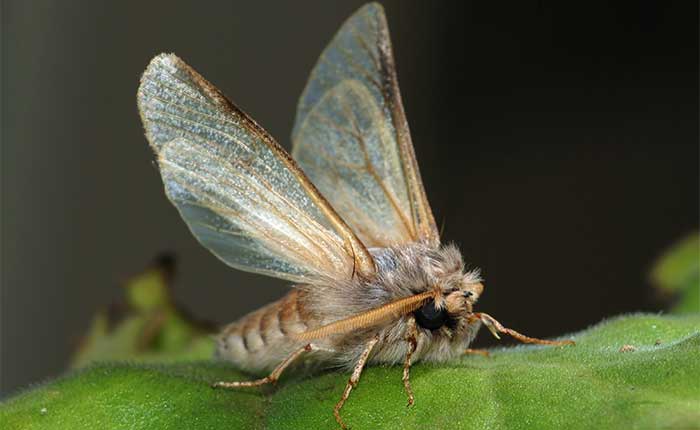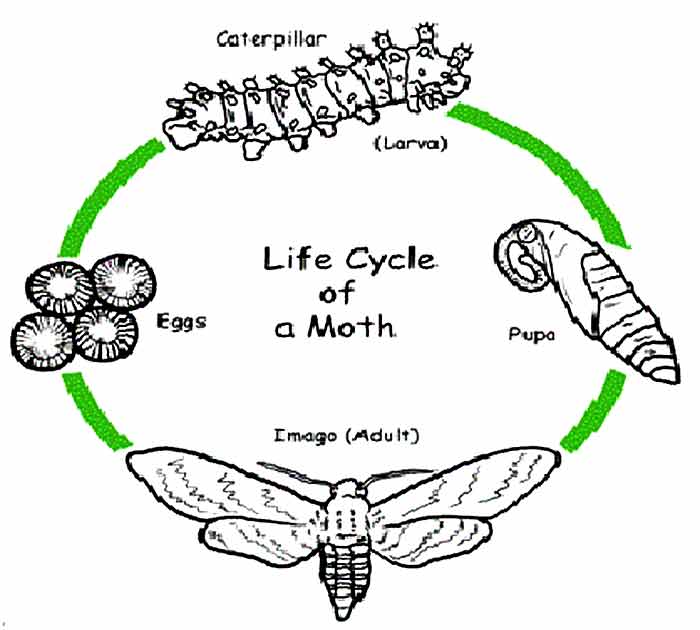Moths
go through a life cycle starting from an egg to being a larva, also known as a caterpillar,
then pupa stage and finally the adult moth.
Each step is equally vital in the growth and development process. There
are a lot of important factors involved in every phase of the development of a
moth, as discussed below.
Table of Contents
The life cycle of a moth
Following are the stages, from egg to adult moth.

First Stage: Egg or Embryonic Stage
At this stage, an embryo develops inside the egg. The egg process begins when adult male and female moths mate and results in fertilization of eggs inside the female moth. A female moth then finds a place to lay eggs; they often find places with lots of plants. The vegetation serves as food for both larvae and caterpillars after hatching from the egg stage.
The eggs take an average of four to ten days to gestate, which means they can take up to 10 days to hatch after they are laid. It takes right environmental conditions to enable an egg to gestate from the egg to formation of embryos and final maturity of a moth.
Average
humidity and warm temperature are essential in the process of gestation to the
creation of caterpillar embryos. The time taken for an egg to gestate depends
on the moth species, but it generally takes an average of 10 days for the
longest moth species to gestate.
A female moth can lay between 45 to 55 eggs over two weeks, and the moth dies shortly afterwards. Other species are known to lay between 200 and 300 eggs in their lifetime. A typical embryo takes averagely ten days to develop, absorb egg nutrients then hatch into a larva, commonly known as a caterpillar.
Second Stage: Larval Stage
After the caterpillar has hatched, it first eats the shell from where it has emerged. It contains a lot of proteins, vitamins, among other essential nutrients necessary for caterpillar survival, growth and development.
When a caterpillar hatches, it is at its first instar. Instars are development stages for moth caterpillars. Moths generally go through moulting and shedding meaning that their skins and shell never grows with their internal organs.
Their skin needs shedding to allow new skin to develop to keep up with the ever-increasing size of the caterpillar. The skin or shell is also referred to as a cuticle.
Once hatched, the caterpillar is at its first instar; even before it has either moulted or shed its skin. Caterpillars often consume their first cuticles after they have discarded it since it contains a lot of proteins, nutrients and other essential nutrients.
Soon after shedding its primary skin, it is considered to be at its second instar.
Some caterpillar species look different after each instar while others appear bigger boot maintains their looks. The number of instars a caterpillar goes through depends on factors such as climate, type of food they consume and the moth species.
Caterpillars averagely consume around 2,700 times their body weight. Eating enables them to grow big and also prepares them for their next life stage, the pupa stage. The time taken for the caterpillar to remain in the ing larva stage depends on climate changes, amount of food, food quality and the caterpillar species.
A caterpillar continues moulting and eating until it reaches the final instar that is the time to become a pupa. Upon being ready to cocoon and transform to being a moth, the caterpillar will wander away from its environment and find a new habitat, one that is humid, safe from predators and warm. Upon finding an appropriate site, the caterpillar sheds the last cuticle, which is usually hard and begins the transformation into the pupa stage.
Third Stage: Pupa Stage
The pupa stage is an exciting part of the moths’ life cycle. In this stage, the caterpillar transforms into an adult moth, developing wings as well. When a moth is at its pupa stage, it builds its body around a structure referred to as a chrysalis.
Caterpillars always spin silk, which they make from the proteins they produce. The caterpillar spins the silk into a cocoon where transformation occurs. The envelope offers protection to the vulnerable larva, and it keeps all organs contained.
The caterpillar consumes the food it ate during the larval stage while it is at this dormant stage. The pupa stage is energy-intensive hence; the caterpillar requires a lot of energy for transformation to take place, also known as metamorphosis.
The caterpillar undergoes a process known as histolysis, whereby individual transformative cells remain dormant and unseen in the pupa stage. The specialized cells break down the caterpillar to a pile of cells.
The reform process, known as histogenesis is where specialized cells organize both DNA and cells in the cocoon, therefore forming an adult moth.
The time taken by a caterpillar in the larva stage depends on moth size, species and the environment. Averagely, moths take between 5 to 21 days to cocoon into a fully-grown moth.
Fourth Stage: Adult Moth
Growing into an adult moth is the final stage in this life cycle, and the moth now has wings. An adult moth is also known as an imago. It takes time for the imago to emerge from the cocoon where it comes out being weak, fragile and soft.
Coming out of the cocoon is severe, the moth comes out having a bloated abdomen and shrivelled wings, thus its unable to fly in its first few hours.
Adult moths have hemolymph, which is bodily fluid. The moths take hours to pump this fluid to wings and enable it to achieve the full-body size and to fly.

Timeline of a Moths life cycle
A moth’s egg takes between 4 to 10 days to hatch depending on environmental factors such as temperature and humidity.
The larva stage varies, some last between 2 months while strange cases such as clothes moths can remain at this stage up to 30 months.
The
pupa stage takes an average of 8 to 10 days. Several adult moths last between
75 and 80 days, depending on the presence of predators and environmental
factors.
The lifespan of a Moth-How long does it live?
The lifespan of a moth depends on the type of species among other factors. Some moths such as yucca moth only survive about two days after metamorphosis.
Others survive a few weeks while others live for a couple of months. In some rare cases, adult moths live for up to 10 months.
In reality, most moths live for a short while due to factors such as poor weather conditions and predators that eat them up before completing their life cycle. Female moths, however, usually die after laying eggs.
Further Reading
- Common Moth Types + Pictures
- How to get Rid of House Moths in 3 Steps
- House Moths – Where They Come from, Identification Causes, Attractants & Habitat
- Life Cycle of a Moth
- What Do Moths Eat? Why do they Feed on Clothes?
- Are Moths Dangerous to Humans & Pets